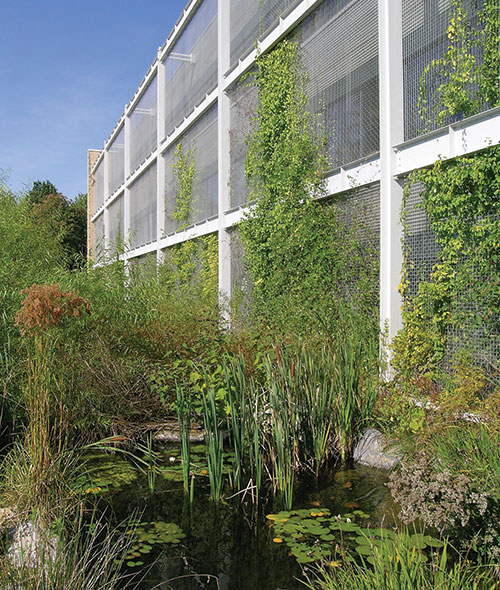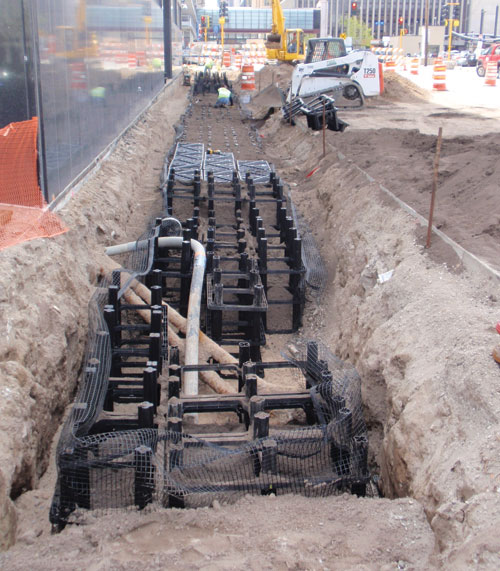Design Options for Greening Urban Environments
The Value of Vertical Green Space
There is some debate as to whether the cost of maintaining green walls offsets its value for addressing a site's environmental considerations. greenscreen's Hill states that further research is being done around soil volumes and maintenance with respect to vertical planting systems but notes that “the trellis systems facilitate the natural growth of the plant materials so the integrity of the screen is not compromised as plants mature.”
Overall, green walls add to the palette of materials and methods that can help to increase and enhance urban green space and bridge the interface between human man-made and green infrastructure. Studies have shown that green walls on building façades help to mitigate outdoor air quality but they also reduce indoor ambient air temperature which adds to energy and cost savings and provides a greater return on investment to projects. Green walls present an additional option for implementing urban green space and enhancing the urban environment.
 |
The National Wildlife Federation Building in Washington, D.C. utilizes a green façade system in conjunction with on-site stormwater management. Photo courtesy of greenscreen® |
Bridging the Building—Site Interface
Green walls are not the only building-site interface for enhancing green space in tight urban areas. Green roofs have been an integral part of the design palette for both architects and landscape architects since the 1960s when they were first constructed in Germany. As green roofs become more an integral part of the urban environment, accessing their components for maintenance and long term sustainability is important. Modular decking systems have been developed to provide easier access to maintain green roofs. These modular decking systems also protect the roofing materials and thus prolong the roof lifespan. In addition, the modular decking systems cover unsightly rooftop penetrations, provide space for irrigation systems and facilitate water drainage from green roof planters.
Modular Decking for Green RoofsModular decking components include prefabricated wooden squares and high density plastic adjustable deck supports. According to Lisa von Gunten, vice president and general manager of Bison Innovative Products, some manufacturers offer prefabricated commercial grade wooden squares or tiles that are “pre-assembled and are “constructed from select cut Brazilian hardwoods that are harvested in an environmentally responsible method, FSC Certified and qualify for LEED points.” To comply with LEED ® and SITES ™ criteria for certification, designers should verify the origin of the wood and confirm the exact species. Deck supports are typically made from polypropylene and contain 20 percent post industrial recycled material so they qualify for points under LEED® Materials and Resources Credit 4. The decking is designed for ADA accessibility. This modular roof decking is held in place via perimeter containment so it does not require anchoring to or penetration of the roof membrane.
| Urban Streetscapes and Storm Water
Minneapolis, Minnesota |
||
Modular underground bioretention cells have been used in Minneapolis, Minnesota on the Marquette and 2nd Downtown Streetscape to meet regulatory stormwater compliance. The Marquette and 2nd Avenue (MARQ2) project was a transit-way streetscape renovation in a 48-block mixed-use stretch of downtown Minneapolis. A modular underground bioretention cell system was installed under pervious pavers to allow stormwater infiltration to tree pits. The streetscape was designed to route stormwater to the soil in the underground bioretention cells and thus eliminates irrigation and reduces runoff. Bob Kost, project landscape architect and director of SEH (Short, Elliot, Hendrickson, Minneapolis, Minnesota), stated that “we were immediately attracted to this cell because of its holistic nature of providing heavy-duty structural pavement support, stormwater treatment and the horticultural benefits of highly accessible soil volumes. Unlike structural soil alternatives, this bioretention cell makes large volumes of lightly compacted soil available to soak up urban stormwater runoff while making this resource available for uptake by the street trees, completing the hydrologic cycle. For the first time in my 30 years of design practice, we finally have a product that allows street trees to function as a measurable, long-term component of civic infrastructure.” For this project 167 street trees were installed and over 19,000 cubic feet (0.45 acre feet or 558.3 m3) of stormwater can be treated with 90 percent of the stormwater from rain events being captured. |










